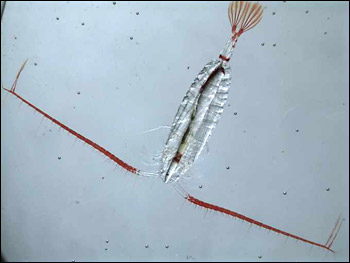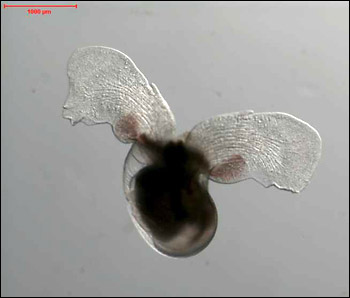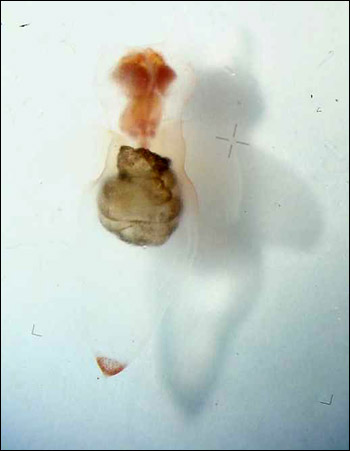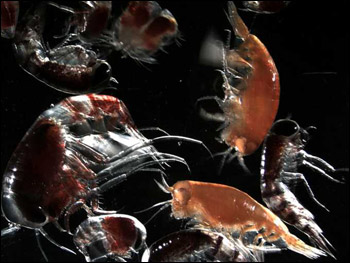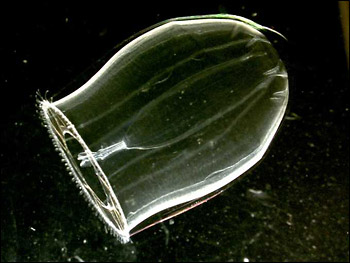Please note: You are viewing
the unstyled version of this website. Either your browser does not support CSS
(cascading style sheets) or it has been disabled. Skip
navigation.
Helen Drost, IOSSeptember 8, 2006
Jenny Hutchings mentioned, in Dispatch 10 – Bongos, that we were planning to drop nets at many different stations. And so we have! To date we’ve collected zooplankton at 10 stations with the last one planned for tomorrow. At each station we deployed 3 different mesh size nylon conical nets. These include a large (236 µm), a medium (150 µm) and 2 very fine (53 µm) nets. All are attached to circular rings that are nicknamed Bongos. Flow meters are secured in the center of these rings to enable quantitative estimates of the water volume filtered and total species abundance. Plankton is a Greek word for wanderer. It is a general term used to describe small organisms suspended in the water. Plankton was traditionally used to describe organisms that cannot swim against most currents. However, many zooplankton, which includes both unicellular and multicellular animals, are actually quite good swimmers and can migrate, on a daily basis, great distances up and down the water column. For instance, copepods (small crustaceans that are a primary food source for many marine animals) can migrate hundreds of meters twice a day at speeds that have been measured from 10 to an astonishing 168 meters per hour (550 ft per hour). We sample at different depths, with nets of different mesh size and at different times of day and night. There is always a diverse assemblage to be found including the ubiquitous copepods, chaetognaths (arrow worms), cnidarians (jelly fish), ctenophores (comb jellies) and amphipods. There are even sea butterflies! They belong to the Mollusca phylum and are commonly known as pteropods (snails that swim). The two species we have seen are Limacina helicina and Clione limacina. The familiar foot of land snails has morphed into wings that flap up and down and enable them to swim through the water. It is wonderful to watch them swim but the story does not end there. These two species are thought to be present only in high latitude waters. This phenomenon is termed bipolar distribution. They are not found anywhere in between. This is possibly due to deep water current transport that links the poles. However, a second theory is that they once were distributed evenly in all areas but competitive interactions with other zooplankton ultimately limited their zones of habitation. One last note about these wondrous pteropods is that Clione limacina feed exclusively on its close relative Limacina helicina. Such specialization makes Clione limacina vulnerable to any change in abundance of Limacina helicina populations. Even though a century has passed since the famous Challenger Expedition, we are still finding new species of zooplankton, especially in the Arctic. Many questions remain unanswered. A comprehensive study of arctic zooplankton is urgently required if, as many scientists warn, climate change threatens to radically alter Polar Regions. Last updated: October 7, 2019 | ||||||||||||||||||||||||
Copyright ©2007 Woods Hole Oceanographic Institution, All Rights Reserved, Privacy Policy. | ||||||||||||||||||||||||


